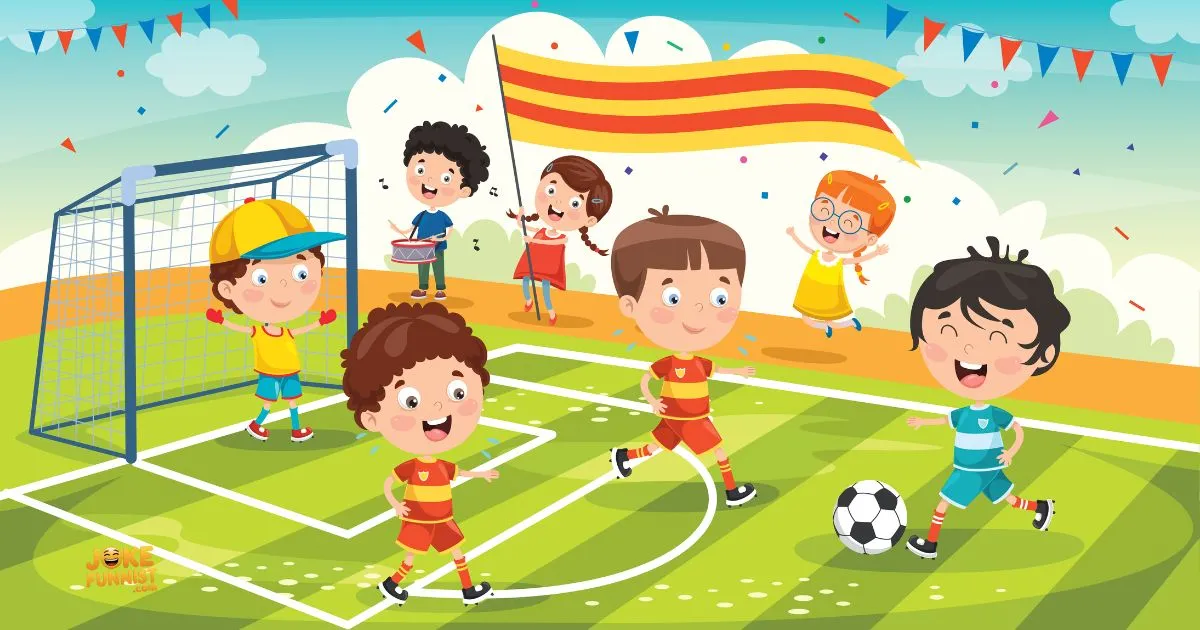“The funniest jokes for kids that will have them giggling non-stop, from classic knock-knocks to clever one-liners!”
Laughter is the best medicine, especially for kids! When it’s a clever riddle, a silly pun, or a classic knock-knock joke, humor is a fantastic way to brighten a child’s day. Jokes not only make children laugh but also help them develop creativity, social skills, and confidence.
Sharing jokes with kids is an excellent way to bond and create lasting memories. If at home, in the classroom, or at a party, the right joke can break the ice and bring everyone together. Plus, children love the opportunity to share their favorite jokes with others, spreading laughter wherever they go.
This collection of funny jokes is specially curated to guarantee giggles for kids of all ages. From easy-to-remember punchlines to clever wordplay, there’s something here for every young comedian. Get ready to hear, “Tell me another one!”
Funny One-Liner Jokes for Kids
- The simplicity and charm of one-liner jokes.
- Why kids love quick and funny lines.
- “Why did the math book look sad? It had too many problems.”
- “I told my computer a joke—it cracked up!”
- “What’s orange and sounds like a parrot? A carrot!”
- “I’m on a seafood diet—I see food and eat it.”
- “What do you call a bear with no teeth? A gummy bear!”
- “Why are ghosts bad at lying? You can see right through them.”
- “What do you call fake spaghetti? An impasta!”
- “Why was the broom late? It swept in.”
- “I ate a clock—it was time-consuming.”
- “How do you organize a space party? You planet.”
- How to create one-liner jokes kids enjoy.
- Where to use these jokes: lunchboxes, notes, and games.
- The value of humor for kids’ development.
- Wrap-up: One-liners that keep kids smiling.
Kids Q&A Jokes That Make You Giggle
- Introduction to Q&A jokes for kids.
- Why kids find Q&A jokes funny.
- “Why did the bicycle fall over? It was two-tired.”
- “Why don’t eggs tell jokes? They’d crack each other up.”
- “What do you call a snowman in summer? A puddle!”
- “Why don’t skeletons fight? They don’t have the guts.”
- “What’s a pirate’s favorite letter? You’d think it’s R, but it’s the C!”
- “Why did the tomato turn red? Because it saw the salad dressing!”
- “What’s brown and sticky? A stick.”
- “Why did the scarecrow win an award? He was outstanding in his field.”
- “What do you call cheese that isn’t yours? Nacho cheese.”
- “Why can’t your nose be 12 inches long? Because then it’d be a foot!”
- How Q&A jokes spark curiosity and laughter.
- Where to use Q&A jokes: classrooms, family dinners, or playdates.
- Encouraging kids to create their own Q&A jokes.
- Conclusion: Q&A jokes make giggling a group activity.
Read more: Flirty Puns to Spark Fun Conversations
Silly Jokes for Kids to Share
- Why sharing jokes is a fun activity for kids.
- “What did the big flower say to the little flower? Hi, bud!”
- “Why was the math book so happy? It found the perfect solution.”
- “What’s a computer’s favorite snack? Microchips!”
- “What do you call a dog magician? A labracadabrador!”
- “Why did the cookie go to the doctor? It felt crumby.”
- “What do you call a cow that can’t moo? A milk dud!”
- “What happens when you tell an egg a joke? It cracks up!”
- “Why don’t elephants use computers? They’re afraid of the mouse!”
- “What do you call a group of musical whales? An orca-stra!”
- “What’s a cat’s favorite color? Purrr-ple.”
- Benefits of kids sharing jokes with peers.
- Using silly jokes to break the ice in new groups.
- Tips for kids to perform jokes confidently.
- How silly jokes encourage positive social interaction.
- Conclusion: Sharing silliness strengthens friendships.
Lighthearted Jokes for Kids’ Parties
- The role of jokes in making parties fun.
- “Why don’t you give Elsa a balloon? She’ll let it go!”
- “What do you get when you cross a snowman and a dog? Frostbite!”
- “What do elves learn in school? The elf-abet!”
- “Why are fish so smart? Because they live in schools!”
- “What kind of key opens a banana? A mon-key!”
- “Why did the teddy bear skip dessert? It was stuffed.”
- “How do you talk to a giant? Use big words.”
- “What’s black and white and red all over? A sunburned zebra!”
- “What kind of tree fits in your hand? A palm tree.”
- “Why did the golfer bring two pairs of pants? In case he got a hole in one!”
- Using jokes to entertain party guests.
- How jokes help break the ice at kids’ parties.
- Organizing a “joke-off” at parties for more fun.
- Encouraging kids to prepare their own jokes for parties.
- Wrap-up: Lighthearted jokes make parties unforgettable.
Clever Jokes for Smart Kids
- The appeal of clever jokes to curious minds.
- “Why was the computer cold? It left its Windows open!”
- “What’s an astronaut’s favorite part of a computer? The space bar!”
- “Why was the equal sign so humble? It knew it wasn’t less than or greater than anyone.”
- “Why did the student eat their homework? The teacher said it was a piece of cake.”
- “What’s a math teacher’s favorite dessert? Pi!”
- “Why did the book join the police? It wanted to go undercover.”
- “What do you call a pencil with two erasers? Pointless!”
- “Why are calendars so smart? They’re full of dates!”
- How do you organize a space party? You planet.”
- “Why do bees have sticky hair? They use honeycombs.”
- The importance of encouraging kids to think critically with humor.
- Using clever jokes as teaching tools.
- How clever jokes can spark intellectual curiosity.
- Why smart kids enjoy decoding wordplay.
- Wrap-up: Clever jokes are a fun way to keep young minds sharp.
Funny Animal Jokes for Kids
- Why kids find animals hilarious in jokes.
- “Why do cows have hooves instead of feet? Because they lactose.”
- “What do you call a sleeping bull? A bulldozer.”
- “Why are fish so good at math? They’re great at fins-traction.”
- “Why do ducks always pay with cash? Because they hate bills!”
- “What do you call a bear with no ears? B!”
- “What’s a cat’s favorite TV show? Claw and Order.”
- “Why don’t elephants play cards? They’re afraid of cheetahs.”
- “Why did the owl invite everyone to the party? It was a hoot!”
- What do you get when you cross a snake and a pie? A python.”
- “Why don’t rabbits get hot in the summer? They have hare-conditioning!”
- Animal jokes as a way to teach kids about creatures.
- How animal humor connects kids to nature.
- Benefits of sharing animal jokes in classrooms.
- Crafting your own funny animal jokes with kids.
- Conclusion: Animal jokes add a wild twist to humor.
Knock-Knock Jokes for Kids to Enjoy
- The timeless appeal of knock-knock jokes.
- Knock-knock joke 1: “Knock, knock. Who’s there? Lettuce. Lettuce who? Lettuce in, it’s cold out here!”
- Knock-knock joke 2: “Knock, knock. Who’s there? Boo. Boo who? Don’t cry, it’s just a joke!”
- Knock-knock joke 3: “Knock, knock. Who’s there? Cow says. Cow says who? No, cow says moooo!”
- Knock-knock joke 4: “Knock, knock. Who’s there? Orange. Orange who? Orange you glad I didn’t say banana?”
- Knock-knock joke 5: “Knock, knock. Who’s there? Atch. Atch who? Bless you!”
- Knock-knock joke 6: “Knock, knock. Who’s there? Harry. Harry who? Harry up, it’s freezing!”
- Knock-knock joke 7: “Knock, knock. Who’s there? Olive. Olive who? Olive you and I miss you!”
- Knock-knock joke 8: “Knock, knock. Who’s there? Banana. Banana who? Knock, knock. Who’s there? Orange. Orange who? Orange you glad I didn’t say banana?”
- Why knock-knock jokes are perfect for kids.
- How to craft knock-knock jokes together.
- Using knock-knock jokes to break the ice.
- The role of repetition in making these jokes funny.
- Tips for kids to deliver knock-knock jokes with flair.
- Knock-knock jokes at parties and gatherings.
- Conclusion: Knock-knock jokes never go out of style.
Classic Jokes Kids Love to Tell
- The enduring charm of classic jokes.
- “Why did the chicken cross the road? To get to the other side!”
- “Why was the math book sad? It had too many problems.”
- “What’s black and white and read all over? A newspaper!”
- “Why do seagulls fly over the sea? Because if they flew over the bay, they’d be bagels!”
- “Why can’t you give Elsa a balloon? She’ll let it go!”
- “What did the zero say to the eight? Nice belt!”
- “Why was six afraid of seven? Because seven eight nine!”
- “What do you call a boomerang that doesn’t come back? A stick!”
- Why classic jokes are timeless.
- The role of classic jokes in teaching humor.
- How classic jokes bond kids across generations.
- Encouraging kids to put a twist on classic jokes.
- Classic jokes as teaching tools in schools.
- Why kids love telling these jokes repeatedly.
- Wrap-up: Classics always bring smiles.
Jokes About School That Kids Find Hilarious
- Why school-themed jokes resonate with kids.
- “Why was the math book so happy? It found the perfect solution.”
- “Why was the pencil jealous? It couldn’t get to the point.”
- “What’s a teacher’s favorite nation? Expla-nation.”
- “Why did the teacher wear sunglasses? Because her students were so bright.”
- “Why did the student eat their homework? The teacher said it was a piece of cake.”
- : “What’s a computer’s favorite snack? Microchips!”
- “Why didn’t the skeleton go to school? He didn’t have the guts.”
- “Why do teachers love their desks? They’re great at keeping things in order.”
- The role of humor in reducing school-related stress.
- How jokes can make learning enjoyable.
- Encouraging kids to come up with school-themed jokes.
- Using jokes to improve classroom engagement.
- Why kids love poking fun at school life.
- Creating laughter-filled classrooms with jokes.
- Conclusion: School jokes turn lessons into laughter.
Silly Riddles and Jokes for Kids
- The fun of combining riddles and jokes for kids.
- “What has hands but can’t clap? A clock.”
- “What has to be broken before you can use it? An egg.”
- “Why did the golfer bring two pairs of pants? In case he got a hole in one!”
- “What gets wetter the more it dries? A towel.”
- “What do you call a dinosaur with an extensive vocabulary? A thesaurus.”
- “What has a face and two hands but no arms or legs? A clock.”
- “What do you call cheese that isn’t yours? Nacho cheese.”
- “What has an eye but can’t see? A needle.”
- “Why don’t skeletons fight? They don’t have the guts.”
- Why riddles enhance critical thinking for kids.
- How to blend riddles and jokes for more fun.
- Tips for kids to solve and share riddles confidently.
- Benefits of riddles and jokes in group activities.
- Encouraging creativity by making up original riddles.
- Conclusion: Silly riddles and jokes make kids think while they laugh.
Fun Jokes for Kids’ Family Gatherings
- The importance of laughter at family gatherings.
- “Why did the turkey join the band? Because it had the drumsticks.”
- “Why can’t you play hide and seek with mountains? Because they’re always peaking.”
- “Why don’t oysters share their pearls? Because they’re shellfish!”
- “What do you call a boomerang that doesn’t come back? A stick.”
- “Why did the scarecrow win an award? He was outstanding in his field.”
- “Why don’t skeletons fight? They don’t have the guts.”
- “What’s a vampire’s favorite fruit? A neck-tarine.”
- “Why did the tomato turn red? Because it saw the salad dressing.”
- How jokes can unite generations.
- Sharing jokes as a family tradition.
- Encouraging kids to perform joke routines at family events.
- Tips for involving everyone in the humor.
- The power of humor to create lasting memories.
- Why family-friendly jokes are important.
- Conclusion: Fun jokes make family gatherings unforgettable.
Jokes That Will Make Kids Laugh Out Loud
- Why do kids love jokes that cause big laughs?
- “Why don’t scientists trust atoms? Because they make up everything!”
- “What do you call a belt made of watches? A waste of time.”
- “Why was the stadium so cool? It was filled with fans.”
- “Why don’t seagulls fly over the bay? Because then they’d be bagels!”
- “What do you call a fake noodle? An impasta!”
- Why did the bicycle fall over? It was two-tired.”
- “What did one wall say to the other? I’ll meet you at the corner.”
- “What do you call a dog magician? A labracadabrador!”
- How laughter boosts kids’ mood and confidence.
- Encouraging kids to find humor in everyday life.
- Tips for kids to deliver jokes with energy.
- Why jokes are a hit during playdates and group activities.
- Creating laugh-out-loud moments with family and friends.
- Using jokes to develop a positive sense of humor.
- Conclusion: Laughter makes life brighter for kids and everyone around them.
Easy Jokes for Kids to Remember
- Why simple jokes are ideal for kids.
- “Why was six afraid of seven? Because seven eight nine.”
- “What do you call a sleeping bull? A bulldozer.”
- “Why did the chicken cross the playground? To get to the other slide.”
- “Why was the computer tired? It had a hard drive!”
- “Why don’t elephants use computers? They’re afraid of the mouse.”
- “Why do fish live in saltwater? Because pepper makes them sneeze!”
- “What kind of tree fits in your hand? A palm tree.”
- “Why don’t eggs tell jokes? They’d crack each other up.”
- The importance of jokes that are easy to memorize.
- How easy jokes help kids build confidence.
- Sharing simple jokes with friends and family.
- Creating opportunities for kids to tell jokes in groups.
- Tips for kids to practice joke delivery.
- Why easy jokes often become kids’ favorites.
- Conclusion: Simple jokes are the foundation of kids’ humor.
Key Insight:
1. What makes a good joke for kids?
A good joke for kids is easy to understand, age-appropriate, and silly enough to make them laugh without requiring too much explanation.
2. Why are jokes beneficial for kids?
Jokes encourage creativity, build social bonds, and help children develop language skills through wordplay and humor.
3. How can parents or teachers use jokes effectively?
Parents and teachers can use jokes to create a positive atmosphere, teach lessons in a fun way, or simply cheer up a child’s mood.
4. What are some examples of funny jokes for kids?
“Why don’t skeletons fight each other? Because they don’t have the guts!” or “What do you call a bear with no teeth? A gummy bear!”
5. Where can kids share these jokes?
Kids can share jokes at family gatherings, school talent shows, or even with friends during playdates and lunchtime.
Final Thought:
Funny jokes are more than just a source of entertainment they’re a way to connect, learn, and share joy. When kids laugh together, they build stronger friendships and create happy memories that last a lifetime.
Encourage the young jokesters in your life to explore their humor and share their favorite jokes. With laughter echoing in the air, every day becomes a little brighter and more fun!

A creative author who brings fresh perspectives and hilarious insights to every piece.











